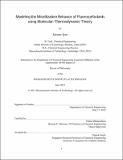| dc.contributor.advisor | Daniel Blankschtein. | en_US |
| dc.contributor.author | Iyer, Jaisree (Jaisree Kannan) | en_US |
| dc.contributor.other | Massachusetts Institute of Technology. Department of Chemical Engineering. | en_US |
| dc.date.accessioned | 2013-10-24T18:12:45Z | |
| dc.date.available | 2013-10-24T18:12:45Z | |
| dc.date.copyright | 2013 | en_US |
| dc.date.issued | 2013 | en_US |
| dc.identifier.uri | http://hdl.handle.net/1721.1/81750 | |
| dc.description | Thesis (Ph. D.)--Massachusetts Institute of Technology, Dept. of Chemical Engineering, 2013. | en_US |
| dc.description | This electronic version was submitted by the student author. The certified thesis is available in the Institute Archives and Special Collections. | en_US |
| dc.description | Cataloged from student-submitted PDF version of thesis. | en_US |
| dc.description | Includes bibliographical references (p. 267-281). | en_US |
| dc.description.abstract | Fluorinated surfactants are an important class of surfactants because they possess properties that are far superior than those of their hydrocarbon analogs. As a result, they are used in a wide variety of applications including in paints, polishes, fire-fighting foams, and emulsion polymerization processes. However, concerns regarding the non-biodegradability and toxicity of fluorinated surfactants have prompted the search for new, benign alternative surfactant formulations that possess micellization properties comparable to those of traditional fluorinated surfactants. With this need in mind, this thesis focuses on gaining a molecular-level understanding of the micellization behavior of traditional fluorinated surfactants, and then using the acquired knowledge to design novel surfactant formulations that can reduce the use of fluorinated surfactants. Molecular-thermodynamic (MT) models were developed to calculate the various contributions to the free energy of micellization for discoidal and biaxial ellipsoidal micelles; two important micelle shapes in the context of fluorocarbon-based surfactants. These models explicitly incorporate the effect of the position-dependent curvature associated with discs and biaxial ellipsoids. Comparison between the models developed here with those that do not explicitly account for the varying curvature shows that accounting for the position-dependent curvature is extremely important in modeling these two micelle shapes. The new MT model for the free energy of micellization is also used to demonstrate the feasibility of realizing biaxial ellipsoidal micelles, a result refuted in the past in many theoretical studies on the basis of average geometrical properties of the micelle. A new computer-simulation-molecular-thermodynamic (CSMT) framework was developed to predict the micellization behavior of mixtures of fluorocarbon-based surfactants. To facilitate the practical implementation of the mixture CSMT framework, which involves the computationally intensive task of simulating several mixed micelles, an approximation to the mixture CSMT model was developed. In this approximation, relevant properties for a mixed micelle are estimated using a micelle-composition based weighted average of the analogous properties obtained from simulations of the single-component surfactant micelles for each of the surfactants comprising the mixture. Therefore, in this approximation, the need for simulating mixed micelles is eliminated. The approximation was found to compare well with the mixture CSMT model for various binary surfactant mixtures considered, except for those containing alkyl ethoxylate surfactants. A rationalization of this finding is presented. CMC predictions made using the mixture CSMT model were found to compare very well with the experimental CMCs for several binary mixtures of linear surfactants, thereby laying the foundation for using the CSMT model to predict micellization properties of mixtures of surfactants that have a more complex chemical architecture. Finally, an MT framework was also developed to predict the micellization properties of mixtures of fluorocarbon-based and hydrocarbon-based surfactants. This mixing reduces the use of fluorinated surfactants in the surfactant formulation, thereby addressing the non-biodegradability and toxicity concerns associated with fluorinated surfactants. An enthalpy of mixing contribution resulting from the interactions between the fluorocarbon tails and the hydrocarbon tails, estimated using the Regular Solution Theory, was included in the MT framework. The ability of the MT framework to predict the coexistence of two types of mixed micelles in solution was demonstrated. The MT framework predictions of micelle population distributions, CMCs, and optimal micelle compositions were compared with the experimental values for various mixtures of fluorocarbon-based and hydrocarbon-based surfactants. The models developed in this thesis provide a molecular level understanding of the micellization behavior of fluorocarbon-based surfactants and their mixtures. The models are able to predict several important micellization properties of surfactants and their mixtures that can guide surfactant formulators in the synthesis, characterization, design, and optimization of surfactant formulations that exhibit desirable properties. | en_US |
| dc.description.statementofresponsibility | by Jaisree Iyer. | en_US |
| dc.format.extent | 281 p. | en_US |
| dc.language.iso | eng | en_US |
| dc.publisher | Massachusetts Institute of Technology | en_US |
| dc.rights | M.I.T. theses are protected by
copyright. They may be viewed from this source for any purpose, but
reproduction or distribution in any format is prohibited without written
permission. See provided URL for inquiries about permission. | en_US |
| dc.rights.uri | http://dspace.mit.edu/handle/1721.1/7582 | en_US |
| dc.subject | Chemical Engineering. | en_US |
| dc.title | Modeling the micellization behavior of fluorosurfactants using molecular-thermodynamic theory | en_US |
| dc.type | Thesis | en_US |
| dc.description.degree | Ph.D. | en_US |
| dc.contributor.department | Massachusetts Institute of Technology. Department of Chemical Engineering | |
| dc.identifier.oclc | 860792989 | en_US |
